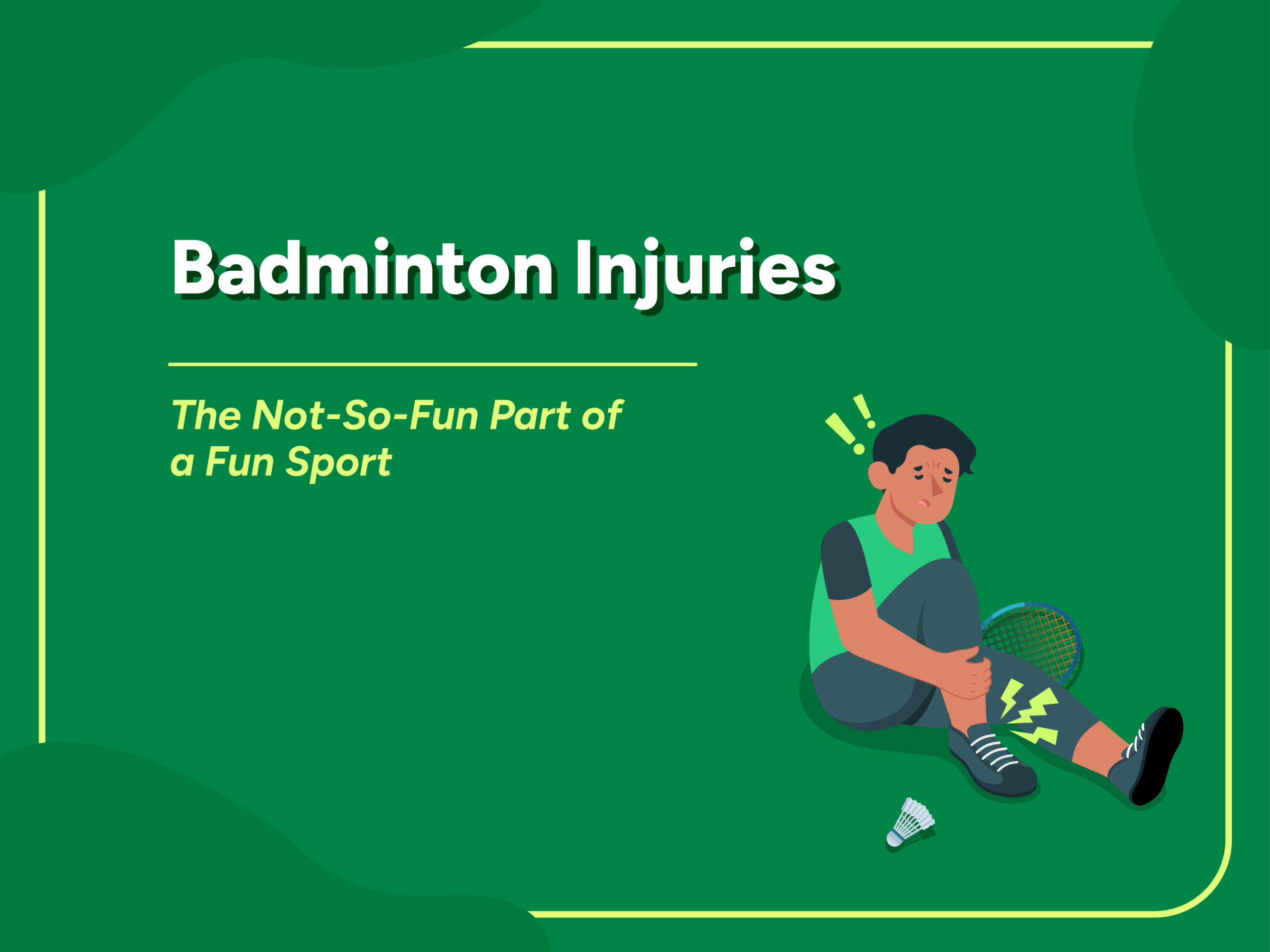It always starts with, “Let’s just play a quick game,” right?
I recently picked up my badminton racket after ages. Not new to the sport, but it had been years. And while it felt great to be back on court, I couldn’t shake the worry that what if I got injured? Sore shoulders, twisted knees… my body wasn’t exactly game-ready after such a long break.
Turns out, badminton isn’t as breezy as it looks. All that jumping, lunging, and smashing adds up, especially if you skip warm-ups (guilty) or dive in like you never took a break. That’s usually when injuries sneak in.
So in this blog, we will be looking at common badminton injuries and how to avoid them, and easy ways you can train smarter at home. Honestly, we all want the same thing, which is to keep playing, stay fit, and avoid ending the weekend with an ice pack.
So, What Are the Most Common Injuries in Badminton?
Before we talk about how to prevent injuries, let’s understand what we’re up against. The common pain points that badminton players often deal with.
- Ankle sprains from those sharp side-to-side lunges.
- Knee injuries, especially around the patellar tendon or ACL.
- Shoulder pain from endless smashes or bad technique.
- Lower back strain thanks to constant twisting and bending.
- Wrist issues from flicks smashes, and trick shots are done without proper grip or strength.
These badminton injuries usually don’t show up out of nowhere. They build up slowly. One day, your wrist feels a bit off. The next day, your shoulder won’t stop aching.
That’s why warm-ups, cooldowns, and regular strength training aren’t optional, but they’re how you keep playing without getting benched.
Watch: A quick breakdown of the most common injuries in badminton and how to avoid them.
The Common Mistakes That Often Lead to Injuries
Knowing the badminton injuries is one thing, but it’s just as important to figure out what’s causing them. Here are some of the most common habits that make injuries more likely.
- Skipping warm-ups: Attempting to recover from pulls and strains due to cold muscles is not ideal.
- Overdoing smashes and jump shots: High-impact movements such as these will increase your risk of sustaining an injury if you do not sustain proper shoulder strength off the court.
- Not taking rest days: Injuries from overuse are always a possibility when playing five times a week without taking any time off.
- Wearing the wrong shoes: Forwards to the side and lateral movements require separate footwear. Shoes intended for running do not provide adequate support for lateral movement and can lead to rolled ankles.
- Pro-level shots prep copying: Though it can be entertaining to view advanced players, ensembling their movement can cause an injury to your wrist, back, or knee if done without proper strength and form.
Play smart, not hard. These tips, and others like them, have the ability to aid in extending the amount of time you are able to play while also alleviating discomfort.
The Injury That Shocked India: Saina Nehwal at the Rio Olympics

If you think injuries only happen to weekend warriors like us, think again. Even top-level athletes aren’t immune; just look at what happened to Saina Nehwal.
Let’s rewind to 2016 – the Rio Olympics. Indian badminton fans had huge hopes for Saina Nehwal. She had already brought home a bronze from the 2012 London Games and was looking sharp going in. But then, something unexpected happened: she lost in the group stage. And a lot of people didn’t get why.
What a lot of folks weren’t aware of back then is that Saina was battling a deep knee injury. The pain was so excruciating that flexing her leg was impossible. Subsequently, she noted that she had been dealing with inflammation and soreness, which made her performance suffer. In her comments after the match, she went as far as to say that the fight with pain was much worse than the actual match.
Her experience serves as a reminder that athletes, no matter how phenomenal, can be hurt. And if they have a hard time, we all really need to be intelligent about our choices.
What To Do If You’re Already Injured
Okay, so maybe the damage is already done. Now what? Let’s talk about what to do when you’re nursing a badminton injury and want to heal the right way.
If you feel a weird ache that doesn’t go away after a day or two, don’t just brush it off or try to power through. Whether it’s a sharp pain, some swelling, or just that “something’s off” feeling, your body’s trying to tell you something. And the smart move? Listen.
For minor injuries, stick to the basics:
- Don’t put weight on the area.
- Rest it.
- Ice it in the first 48 hours to help with swelling.
- Once the pain eases a bit (and only then), try a little light stretching.
But if it’s still bothering you after a week or messing with your usual movements, it’s time to get it checked, ideally by a physio or someone who knows sports injuries.
And let’s drop the whole “no pain, no gain” mindset. Pain isn’t weakness, it’s your body waving a red flag. Ignoring it? That’s how you end up benched for months.
Injury Prevention Starts Here:
Badminton Workout at Home:
The good news? You don’t need a court to start protecting yourself. A smart workout at home can do wonders for your game and your joints.
Can you really train for badminton without stepping on the court? Absolutely. In fact, some of the best preparation happens off the court. This is especially helpful if you’re stuck indoors or just want to build better agility and strength.
Here’s what your at-home routine can include:
1. Dynamic Warm-up (5 to 7 minutes)
Start with high knees, arm circles, jumping jacks, lateral shuffles, and lunges with a twist to get your joints moving and muscles ready.
2. Footwork and Body Conditioning
Badminton is all about quick feet and a responsive body. Shadow footwork to mimic court movements, add skater hops and ladder drills for speed and strengthen your lower body and core with squats, glute bridges, and planks. Resistance bandwork can help protect your shoulders too.
3. Flexibility and Mobility
Finish with stretches like downward dog, cat-cow, and hamstring stretches. This improves your range of motion and keeps joints healthy.
You don’t need fancy equipment, just a yoga mat, some floor space, and consistency.
Recommended reads: Want to level up your technique safely? learn the meaning behind common hand signals in badminton. It adds a layer of smart play to your game.
Wrapping Up: Play Smart, Stay Fit
Badminton is one of those games you just can’t get enough of. With the quick rallies, sneaky drop shots, and the whole mental game, it’s a blast. But let’s be real, it takes a toll if you’re not looking after your body.
So yeah, warm up, stretch, build a little strength, and don’t ignore those rest days. You don’t need to train like a pro, just be consistent and listen when your body says, “Not today.”
Need a place to play or practice what you’ve learned? Explore badminton courts near you on Playo!





0 Comments